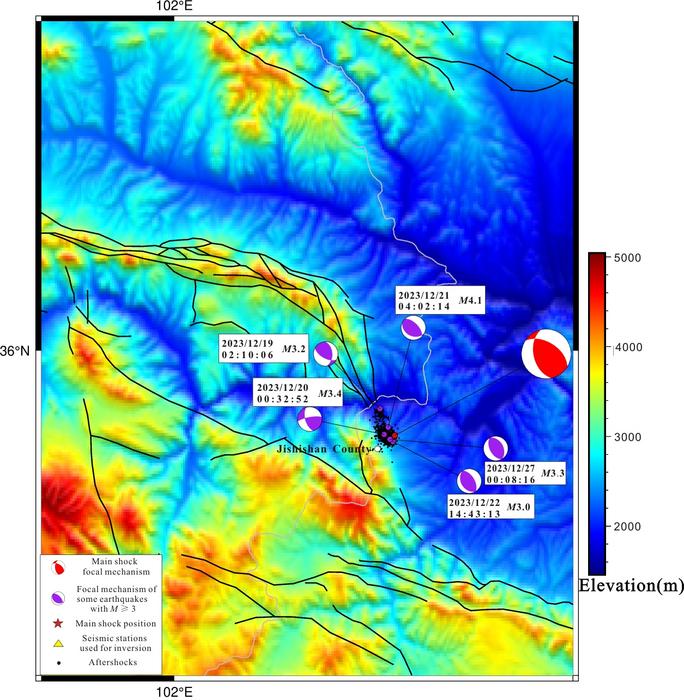
On January 8, 2025, the journal Earth and Planetary Physics published a groundbreaking study led by Xu Tairan at the China Earthquake Networks Center. The study sheds light on the seismogenic characteristics of a significant seismic event: the Ms 6.2 earthquake that struck Jishishan County, Gansu Province, China, in 2023. This research not only provides insights into the mechanics of this specific earthquake but also serves as a vital contribution to our broader understanding of seismic activities in the region.
The study utilized advanced techniques such as relocation methods, focal mechanism solutions, and the inversion of rupture processes to analyze the seismic data. The findings revealed that both the main shock and aftershocks predominantly occurred at a depth of approximately 12 kilometers. Notably, various analytical approaches demonstrated a high degree of consistency in depth readings, thereby bolstering the legitimacy of these findings. This multimodal exploration into the earthquake phenomena emphasizes the importance of contrastive methodologies in seismology for obtaining a well-rounded understanding of earthquake dynamics.
One of the most striking aspects of the study is its focus on the aftershock patterns that developed after the main event. The aftershocks were found to extend predominantly in a unidirectional northwest-northwest (NNW) orientation. Notably, the main shock exhibited characteristics of a reverse thrust, complemented by a minor dextral strike-slip mechanism. This dual nature of movement highlights the complexity of fault lines in geological structures, indicating interactions between different tectonic forces that can influence seismic behavior.
The Lajishan Fault Zone, a significant geological feature in this region, emerged as a focal point of consideration within the research. The earthquake was attributed to the activation of faults situated along the northern margin of this fault zone. The study emphasized that the compressive forces acting on both flanks of the Lajishan Fault Zone resulted in geological phenomena such as mountain uplift and even landslides, illustrating the severe consequences of tectonic shifts. Understanding these interactions sheds light on the broader implications for land stability and seismic safety in the surrounding areas.
Incorporating a historical perspective, the research also examined past seismic events, particularly the 2022 MS 6.9 Menyuan earthquake and the 2019 Ms 5.7 Xiahe earthquake. This historical comparison revealed intriguing relationships between these seismic occurrences, providing a clearer picture of the underlying stress field acting on the region. By integrating historical GPS data, geological surveys, and principal stress field data, the team was able to infer that recent seismic activities were part of a broader continuum of geological dynamics that have characterized the region over time.
The activation of secondary faults during seismic events further complicates the understanding of how earthquakes manifest in this region. The findings suggested that when the primary fault experiences significant movement, it can induce activity in adjacent fault lines, leading to a cascade of seismic events. This has crucial implications for earthquake preparedness and risk assessment in densely populated areas surrounding the Lajishan Fault.
Moreover, the study’s detailed exploration of focal mechanisms provides critical insights for engineers and urban planners working towards mitigating earthquake risks. With population growth and increased infrastructural demands in areas prone to earthquakes, understanding the potential for secondary fault activation is vital. This knowledge can inform construction practices, ensuring structures are resilient to both primary and secondary seismic shocks.
One cannot overlook the rapidly evolving field of seismology, where cutting-edge technologies such as machine learning and real-time monitoring systems are becoming integrated into traditional geological studies. As data becomes more abundant and complex, economists, sociologists, and urban planners must collaborate with geophysicists to develop holistic approaches to disaster risk management, urban development, and community preparedness.
The study opens avenues for further research into the seismogenic mechanisms of the Lajishan Fault Zone. By examining the intricate relationships between various seismic events, scientists can develop predictive models that could potentially foresee future seismic occurrences. Such advancements could revolutionize how societies respond to earthquakes, shifting from a reactive to a proactive approach.
Overall, the publication of Xu Tairan and his team’s research marks a significant contribution to our understanding of the seismic activities in Gansu, China. Their findings not only enhance the scientific community’s knowledge but also hold practical implications for residents in earthquake-prone regions. By integrating historical data with current seismic phenomena, we can better prepare for the uncertainties that these geological forces entail, thus fostering a culture of resilience in the face of natural disasters.
In conclusion, the intricate dynamics of earth movements portrayed in this study underline the tremendous need for continuous research and collaboration among different scientific disciplines. As societies evolve, so must our understanding of the forces that shape our world. The insights gleaned from this research serve as a critical reminder that while the earth can be unpredictable, scientific inquiry offers us the tools to mitigate risks and prepare for the future.
Subject of Research: Seismic mechanisms and seismogenic environment of the Ms 6.2 earthquake in Jishishan, Gansu, China.
Article Title: The seismic mechanisms and seismogenic environment of the Ms 6.2 earthquake in Jishishan, Gansu, China: Evidence from relocation, focal mechanisms, and rupture processes
News Publication Date: January 8, 2025
Web References: http://dx.doi.org/10.26464/epp2025016
References: Not specified
Image Credits: Credit: Beijing Zhongke Journal Publishing Co. Ltd.
Keywords: Earthquake, Jishishan County, seismic mechanisms, Lajishan Fault Zone, aftershocks, geological features, risk assessment, earthquake preparedness, focal mechanism, tectonic forces, seismogenic processes, historical seismic events.
Tags: advanced seismology techniquesaftershock patterns in seismologyChina earthquake networks researchearthquake depth analysisearthquake focal mechanismsearthquake mechanics insightsJishishan earthquake analysisMs 6.2 earthquake Gansunorthwest-northwest aftershock orientationrupture dynamics researchseismic data relocation methodsseismic event study 2023





